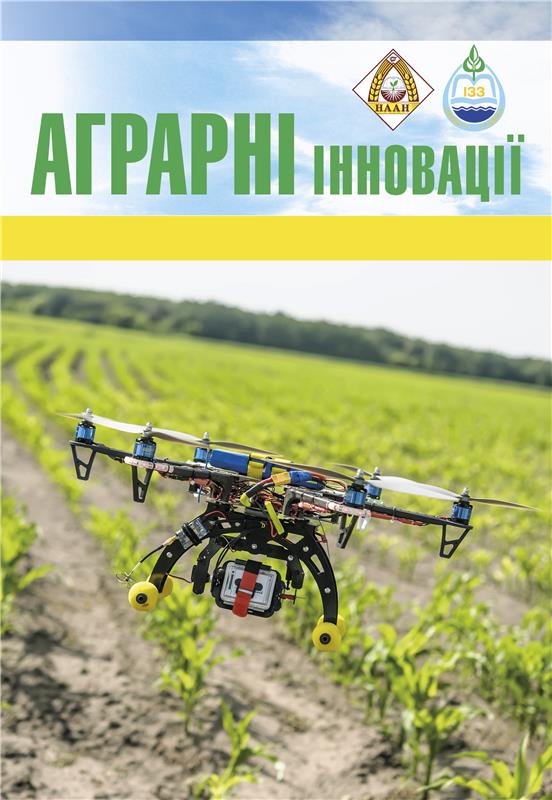ENERGY ANALYSIS OF THE TECHNOLOGY OF GROWING SOFT WINTER WHEAT VARIETIES DEPENDING ON DIFFERENT PLANT PROTECTION SCHEMES AND SOWING DATES IN THE SOUTHERN STEPPE
Abstract
The purpose of the article is to conduct an energy analysis of the developed elements of agricultural technology for growing soft winter wheat varieties under irrigation.Research methods and materials. The methodological basis of this study is: empirical (field experiments and observations; measurement of indicators of the research object; comparison of the impact of elements of agricultural technologies), theoretical (hypothesis formulation and formation of conclusions based on research results; statistical; mathematical). The results. Energy costs for the formation of winter wheat cultivation technology under irrigation conditions in the South of Ukraine were characterized by a certain stability and varied in the range from 36.1 GJ/ha (Zira variety, control without plant protection)to 37.3 GJ/ha (Ovidii variety, integrated plant protection).The energy efficiency coefficient, which is considered one of the most important energy indicators, was less than 2.0 in the variants with the Zira variety without plant protection, as well as with a biological system of protection against harmful organisms. This indicator increased to 2.32, or by 25.1–25.7%, when growing the Ovidii variety with an integrated plant protection system. The energy intensity of 1 ton of grain increased to 7.2–7.6 GJ in the variants with bioprotection, as well as in the control variant of the first sowing period for growing the Zira variety. The lowest energy consumption for the formation of 1 ton of winter wheat grain yield (6.0–6.2 GJ) was recorded in the Ovidii variety for the formation of chemical and integrated plant protection, which indicates the energy advantage of this combination of the studied variants. Conclusions. The highest energy gain within 63.1 GJ/ha was formed on the Maria variety when sowing on September 20 and when using chemical plant protection. The energy efficiency coefficient of the developed winter wheat growing technology turned out to be very high – over 2.81 in all combinations of the studied factors and their variants. The energy intensity of winter wheat grain was maximum (4.54 GJ/t) on the Ovidii variety during the third sowing period and without plant protection.Energy analysis proved the advantage in terms of increasing the energy input of products over 82 GJ/ha when sowing on September 15 and 25 and when using chemical plant protection against harmful organisms. The energy gain decreased by 38.3% when sowing on October 15 in the absence of plant protection. The energy efficiency coefficient in the same combination of variants exceeded 3.0.The highest energy intensity of 5.01 GJ/ha was recorded when sowing on October 15 (fifth term) and without plant protection. The minimum of this indicator (4.13 GJ/t) was found in the variant with sowing on September 25 against the background of chemical plant protection, which was 21.3% less than the above-mentioned variant. The energy gain was the greatest in the Ovidii variety with integrated plant protection – 49.4 GJ/ha, which was 61.1% more than the control variant of the Zira variety. With the cumulative effect of protection agents, the highest energy efficiency coefficient was obtained – 2.32. The maximum energy intensity of the grown products increased to 7.2–7.6 GJ in the second and first variants of factor B (bioprotection, control).
References
2. Ткачук О. П. Еколого-економічна та біоенергетична оцінка технологій вирощування пшениці озимої після бобових багаторічних трав. Зернові культури. 2022. Т. 6. № 1. С. 124–132. https://doi. org/10.31867/2523-4544/0215.
3. Nedilska U. Features of growing and yield potential of energy culture. Podilian Bulletin: Agriculture, Engineering, Economics. 2022. № 34. Р. 45–51. https:// doi.org/10.37406/2706-9052-2021-1-6.
4. Мазур В. А., Дідур І. М., Панцирева Г. В., Мордванюк М. О. Енергетична ефективність технологічних прийомів вирощування нуту в умовах зміни клімату. Сільське господарство та лісівництво. 2022. № 25 (2). С. 5–13.
5. Квітко Г. П., Михальчук Д. П., Карасевич В. В. Перспективи вирощування нуту посівного в умовах Лісостепу України. Корми і кормовиробництво. 2013. Вип. 75. С. 113–120.
6. Каленська С. М., Новицька Н. В., Барзо І. Т. Економічна ефективність вирощування нуту в умовах правобережного Лісостепу України. Молодий вчений. Сільськогосподарські науки. 2014. № 10(13). С. 18–20.
7. Palamarchuk V., Honcharuk I., Telekalo N., Krychkovskyi V., Kupchuk I., Mordvaniuk M. Modeling of hybrid cultivation technology corn to ensure energy efficiency for sustai. Ukrainian Journal of Ecology. 2021. № 11(7). Р. 204–211. doi: 10.15421/2021_260.
8. Білоножко М. А., Руденко І. С., Мойсеєнко В. І. та ін. Рослинництво з основами землеробства. Київ, 1986. 224 с.
9. Соловей Д. Ю. Досвід застосування енерґетичного аналізу для оцінки технологічних процесів і технологій у рослинництві. Економіка АПК. 2004. № 4. С. 91–94.
10. Мазур О. В. Економічна та енергетична ефективність вирощування сортів квасолі звичайної. Сільське господарство та лісівництво. 2018. № 8. С. 152–159.
11. Гадзало Я.М. Вожегова Р.А. Лікар Я.О. Продуктивність сортів пшениці озимої залежно від строків сівби, біологічної та хімічної систем захисту рослин від хвороб і шкідників в умовах зрошення. Зрошуване землеробство. 2023. Вип. 79. С. 25–32. https://doi. org/10.32848/0135-2369.2023.79.3.
12. Гадзало Я. М., Вожегова Р. А., Лікар Я. О. Продуктивність сортів пшениці озимої залежно від елементів агротехнології в умовах зрошення. Зрошуване землеробство. 2024. Вип. 82. С. 11–19. https://doi.org/10.32848/0135-2369.2024.82.2
13. Гадзало Я.М., Вожегова Р.А., Лікар Я.О. Продуктивність сортів пшениці озимої залежно від різних схем захисту рослин в Південному Степу. Agriculture and forestry. 2024. № 4(35). С. 97–108. https://doi.org/10.37128/2707-5826-2024-4-9.
14. Вожегова Р.А., Лавриненко Ю.О., Малярук М.П. та ін. Методика польових і лабораторних досліджень на зрошуваних землях. Херсон: Грінь Д. С., 2014. 286 с.






